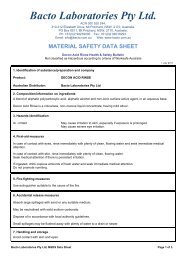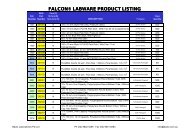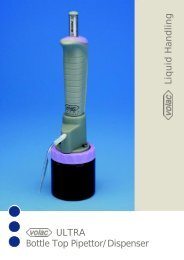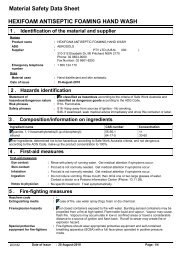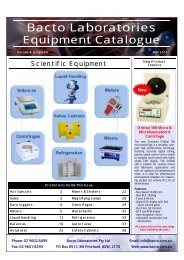BD Falcon⢠Cell Culture Products - Bacto Laboratories
BD Falcon⢠Cell Culture Products - Bacto Laboratories
BD Falcon⢠Cell Culture Products - Bacto Laboratories
You also want an ePaper? Increase the reach of your titles
YUMPU automatically turns print PDFs into web optimized ePapers that Google loves.
Unique Surface Chemistry<br />
for Enhanced <strong>Cell</strong> <strong>Culture</strong><br />
Consistent cell culture conditions are<br />
required for reproducible research<br />
results. In the manufacture of all cell<br />
cultureware, hydrophobic polystyrene<br />
is permanently rendered hydrophilic<br />
to support cell attachment and<br />
spreading. 1,2,3 The consistency of this<br />
surface depends on the treatment<br />
method used.<br />
Many manufacturers have long used<br />
atmospheric plasma treatments (i.e.,<br />
corona) to create hydrophilic surfaces.<br />
In corona treatment, a high-voltage<br />
discharge creates a reactive gas plasma<br />
above the growth surface of the vessel.<br />
In this process, the highly interactive<br />
gas-plasma mixture is exposed to<br />
ambient air. The consistency of<br />
the treatment surface can therefore<br />
be compromised by day-to-day<br />
environmental changes.<br />
At <strong>BD</strong> Biosciences, molded polystyrene<br />
vessels are placed inside a chamber<br />
where a partial vacuum is created. A<br />
proprietary mixture of gases is fed<br />
into the chamber and a controlled<br />
electrical discharge is used to form a<br />
gas plasma. The enclosed, highly<br />
controlled environment prevents<br />
contamination from the air,<br />
ensuring a pure and consistent<br />
treatment surface.<br />
A major research investment<br />
by <strong>BD</strong> Biosciences resulted in the<br />
development of this unique vacuum<br />
gas-plasma process used to produce<br />
both <strong>BD</strong> Primaria and traditional<br />
tissue-culture (TC) surfaces on<br />
<strong>BD</strong> Falcon dishes, plates, flasks<br />
and roller bottles.<br />
The incorporation of nitrogencontaining<br />
cations has been correlated<br />
to attachment and spreading of primary<br />
endothelial cells in a clonal cellgrowth<br />
assay. 4 The complex surface<br />
on <strong>BD</strong> Primaria cultureware is<br />
homogeneous and stable and has been<br />
in use by researchers for over a decade to<br />
improve attachment and differentiation<br />
of a variety of cell types. For example,<br />
cell biologists have used <strong>BD</strong> Primaria<br />
for cultivating hepatocytes, 5,6 neuronal<br />
cells 7 and other endothelial cells. 8<br />
The surface chemistry of <strong>BD</strong> Primaria<br />
products is confirmed by Electron<br />
Scanning for Chemical Analysis (ESCA).<br />
<strong>BD</strong> Biosciences’ cell culture products<br />
meet high quality control standards.<br />
All of our cell culture offerings are<br />
manufactured under the registered<br />
ISO 9000 series Quality Systems. A<br />
sensitive clonogenic assay is used to<br />
validate the specific conditions used to<br />
treat each new TC product. Routine,<br />
72-hour confluency testing ensures<br />
lot-to-lot quality. Our vacuum gasplasma<br />
treatment process makes<br />
<strong>BD</strong> Falcon cell cultureware your best<br />
choice — for confidence in the consistency<br />
of your cell culture conditions.<br />
References<br />
1. Ertel, S., et al., Endothelial cell growth on<br />
oxygen-containing films deposited by radiofrequency<br />
plasmas; the role of surface carbonyl<br />
groups. Biomater. Sci.: Polym. Ed.<br />
3:163 (1991).<br />
2. Curtis, A.S.G., et al., Substrate hydroxylation<br />
and cell adhesion. J. <strong>Cell</strong> Sci. 86:9 (1986).<br />
Traditional Tissue <strong>Culture</strong><br />
Traditional Tissue <strong>Culture</strong><br />
<strong>BD</strong> Primaria<br />
3. Ramsey, W.S., et al., Surface treatments and<br />
cell attachment. In Vitro 20:802 (1984).<br />
4. Chilkoti, A., et al., Investigating the relationship<br />
between surface chemistry and endothelial<br />
cell growth: partial least-squares regression<br />
of the static secondary ion mass spectra<br />
of oxygen-containing plasma-deposited films.<br />
Analytical Chemistry 67:2883 (1995).<br />
5. Boisclair, Y.R., et al., Role of the Suppressor<br />
of Cytokine Signaling-3 in Mediating the<br />
Inhibitory Effects of Interleukin-1ß on the<br />
Growth Hormone-dependent Transcription<br />
of the Acid-labile Subunit Gene in Liver<br />
<strong>Cell</strong>s. J. Biol. Chem. 275(6):3841 (2000).<br />
6. Braun, J.R., et al., The Major Subunit of the<br />
Asialoglycoprotein Receptor Is Expressed on<br />
the Hepatocellular Surface in Mice Lacking<br />
the Minor Receptor Subunit. J. Biol. Chem.<br />
271(35):21160 (1996).<br />
7. Holgado-Madruga, M., et al., Grb2-associated<br />
binder-1 mediates phosphatidylinositol 3-<br />
kinase activation and the promotion of cell<br />
survival by nerve growth factor. PNAS USA<br />
94:12419 (1997).<br />
8. Silverman, D.J., et al., Primary isolation of<br />
human umbilical vein endothelial cells on a<br />
surface-modified tissue culture dish. <strong>BD</strong>L<br />
Monograph (1986).<br />
Additional References<br />
Chat, G. and Coca-Prados, M., Comparison of<br />
tissue culture systems for the growth of ciliary<br />
epithelial cells. <strong>BD</strong>L Monograph (1986).<br />
Chinn, J.A., et al., Laboratory preparation of<br />
plasticware to support cell culture. J. Tissue<br />
<strong>Culture</strong> Methods 16:155 (1994).<br />
<strong>BD</strong> Primaria <br />
When chick embryo spinal<br />
cord neurons are cultured on<br />
<strong>BD</strong> Primaria, growth is enhanced<br />
and extensive neurite development<br />
occurs (above, right). In this experiment,<br />
cells clumped and detached<br />
from traditional TC plates (above,<br />
left) after 20 days in culture, but<br />
remained viable and differentiated<br />
on Primaria.<br />
Note: At pH 7, carboxy groups may be slightly<br />
dissociated and assume a negative (anionic)<br />
charge. Amine groups may protonate and<br />
assume a positive charge (cationic).<br />
www.bdbiosciences.com<br />
3



